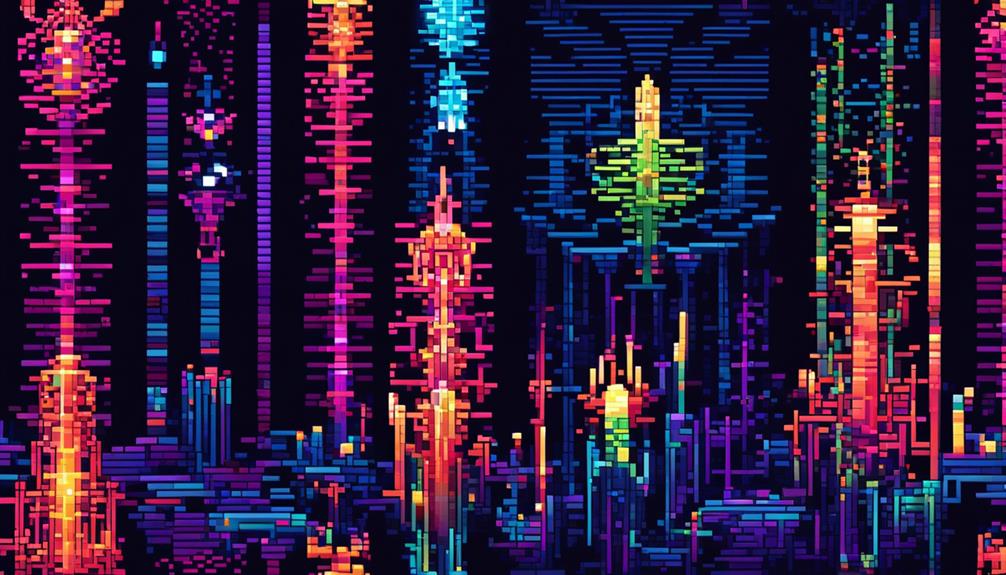Fiber optics have revolutionized the world of lighting, offering a multitude of possibilities for DIY projects and applications. From enhancing home decor to creating stunning costumes and wearables, the durability and versatility of fiber optics make them an ideal choice.
With the ability to carry light over long distances, weather-proofing and washability become a non-issue, while the availability of different diameters and types allows for a wide range of lighting effects.
But how exactly can one attach lights to fibers and manipulate them to achieve visually pleasing outcomes? This discussion will explore the fascinating world of DIY fiber optic projects and applications, providing insights into the process and inspiring creativity along the way.
Key Takeaways
- Fiber optic technology offers a versatile and innovative way to incorporate lighting effects in home decor, fashion, and wearable accessories.
- Different types of fiber optics, such as end emitting fibers and side emitting fibers, can be used to create various lighting patterns and effects, including light-painting effects, diffused glows, and defined lines of light.
- Fiber optic installation techniques, such as using superglue, epoxy, heat shrink tubes, and sanding, are important for attaching lights to fibers and creating unique lighting patterns.
- Fiber optic technology has a wide range of applications, including outdoor lighting, Christmas decorations, jewelry and accessories, science and technology (such as sensors and communication systems), and audio and music projects.
Fiber Optic Lighting for Home Decor
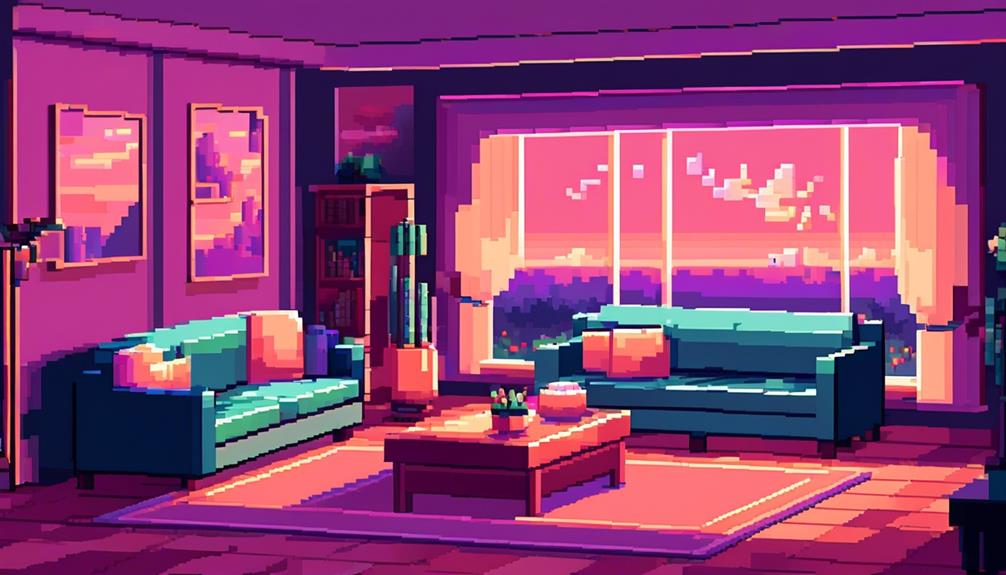
Fiber optic lighting is an innovative and practical solution for enhancing the ambiance and aesthetics of home decor projects. With its durability, versatility, and simplicity, it has become a popular choice for DIY enthusiasts looking to add lighting effects to their homes.
There are two main types of fiber optic lighting: end emitting fibers and side emitting fibers. End emitting fibers have bright points of light at the ends, making them ideal for creating tiny stars or light-painting effects. These fibers are commonly used in applications where the focus is on creating small, focused points of light. On the other hand, side emitting fibers gradually let light escape along the length, resulting in an even glow and diffused lines of light. This type of fiber optic lighting is perfect for creating a more subtle and diffused lighting effect.
When it comes to fiber optic projects for home decor, there are various options available. Multi-strand end glow cable, fiber optic ribbon cables, and fiber optic fabric are some common variants used for flexible lighting effects. These materials can be easily integrated into different home decor projects, such as accent lighting in ceilings, walls, or furniture.
In order to attach lights to the fibers, various methods can be employed. Superglue, heat shrink tubes, and heat manipulation techniques can all be used to secure lights onto the fibers. These techniques allow for creative and customizable lighting effects, further enhancing the overall decor scheme.
Fiber Optic Costumes and Wearables
Fiber optic costumes and wearables offer a fashionable way to incorporate illuminated accessories into outfits. With the use of end emitting fibers, tiny stars and light-painting effects can be created. Side emitting fibers, on the other hand, allow for defined lines of light and diffused glows.
Fashionable Fiber Optics
Fashionable fiber optics, specifically in the realm of fiber optic costumes and wearables, offer an innovative and visually stunning approach to incorporating lighting effects in attire and accessories.
Here are three key points about fiber optic costumes and wearables:
- Fiber optics are a durable and versatile solution for adding lighting effects to wearables and costumes. With fewer lights and less power required, fiber optics are ideal for creating stunning visual effects.
- Fiber optics have the unique ability to transmit light far from the source of illumination, making them weather-proof and washable for costumes. This durability ensures that the lighting effects remain intact even in challenging conditions.
- Available in various diameters, shapes, and types designed for lighting, fiber optics can be manipulated to create different lighting patterns and effects. Whether it's light-painting effects or intricate patterns, fiber optics provide endless possibilities for creating visually pleasing wearables and costumes.
Incorporating fiber optics into fashion allows for a seamless integration of technology and design, resulting in truly remarkable and eye-catching creations.
Illuminated Wearable Accessories
In the realm of wearable technology, incorporating fiber optics into costumes and accessories offers a cutting-edge and visually captivating way to integrate lighting effects. Fiber optics, with their durability and versatility, provide a simple yet effective means of adding lighting to wearable accessories.
End emitting fibers, which have bright points of light at the ends, are ideal for creating visually pleasing light-painting effects. On the other hand, side emitting fibers allow light to escape along their entire length, providing a diffused glow suitable for under-lit elements or defined lines of light.
Various types of fiber optic variants, such as multi-strand end glow cables, fiber optic ribbon cables, and fiber optic fabric, offer flexibility in achieving desired lighting effects. Techniques like using superglue, diffused LEDs, and heat can be employed to attach lights to fibers and manipulate them to create unique lighting patterns.
DIY Fiber Optic Outfits
The integration of fiber optics into DIY outfits, such as fiber optic costumes and wearables, offers a technologically advanced and visually captivating way to incorporate lighting effects. Here are three key benefits of using fiber optics in DIY outfits:
- Easy DIY fiber: Fiber optics are easy to work with, making it accessible for DIY enthusiasts to create their own illuminated outfits. With a little bit of creativity and basic knowledge of fiber optics, anyone can design their own unique and eye-catching costume or wearable.
- Optical fiber versatility: Fiber optics come in various diameters, shapes, and types, allowing for endless design possibilities. Whether you want a subtle glow or a vibrant burst of light, there's a fiber optic option to suit your needs.
- Fibers directly integrated: Unlike traditional lighting elements, which require bulky wires and power sources, fiber optics can carry light far from the source. This means that you can incorporate the fibers directly into your outfit, making it weather-proof and washable.
With fiber optic costumes and wearables, you can bring your creative vision to life and stand out from the crowd with mesmerizing lighting effects.
DIY Fiber Optic Wall Art
When it comes to DIY Fiber Optic Wall Art, there are two key points to consider: designing fiber optic patterns and installing fiber optic lighting.
Designing the patterns involves creating visually appealing layouts and arrangements of the fiber optic strands. This requires careful planning and attention to detail to create stunning and unique fiber optic wall art pieces.
Installing the lighting involves attaching the lights to the fibers and manipulating them to achieve the desired effects. This step also requires careful planning and attention to detail to ensure that the lights are properly attached and positioned for optimal illumination.
Both aspects of DIY Fiber Optic Wall Art require careful planning and attention to detail to create visually appealing and unique pieces.
Designing Fiber Optic Patterns
Fiber optic patterns can be intricately designed to create stunning DIY wall art, utilizing the versatile and durable nature of fiber optics. With a range of fiber types and attachment methods, the possibilities for creating unique light patterns are endless.
Here are three key considerations when designing fiber optic patterns:
- End Emitting Fibers: These fibers create bright points of light at the ends, perfect for light-painting effects or creating focal points in the pattern.
- Side Emitting Fibers: These fibers gradually let light escape along the length, creating an even glow. They are ideal for defined lines of light or under-lit elements in the pattern.
- Fiber Types: Variants such as multi-strand end glow cable, fiber optic ribbon cables, and fiber optic fabric offer flexibility and diverse lighting effects.
Installing Fiber Optic Lighting
Installing fiber optic lighting for DIY fiber optic wall art requires careful consideration of attachment methods and fiber types, as well as a precise and technical approach to ensure a successful installation. There are various methods for attaching lights to fibers, including using superglue, epoxy, heat shrink tubes, and fiber manipulation techniques like sanding and heat distortion. Additionally, the choice of fiber type is crucial to achieve the desired lighting effect. End Emitting Fibers create bright points of light at the ends, perfect for a light-painting effect, while Side Emitting Fibers gradually let light escape along the whole length, creating an even glow. To engage the audience and provide a visual reference, here is a table showcasing some common types of DIY fiber optic wall art:
| Fiber Type | Description |
|---|---|
| End Emitting Fibers | Bright points of light at the ends and little light escaping along the strands. Perfect for creating a light-painting effect. |
| Side Emitting Fibers | Gradually let light escape along the whole length, creating an even glow. Great for projects requiring defined lines of light or under-lit elements. |
Fiber Optic Garden and Outdoor Lighting
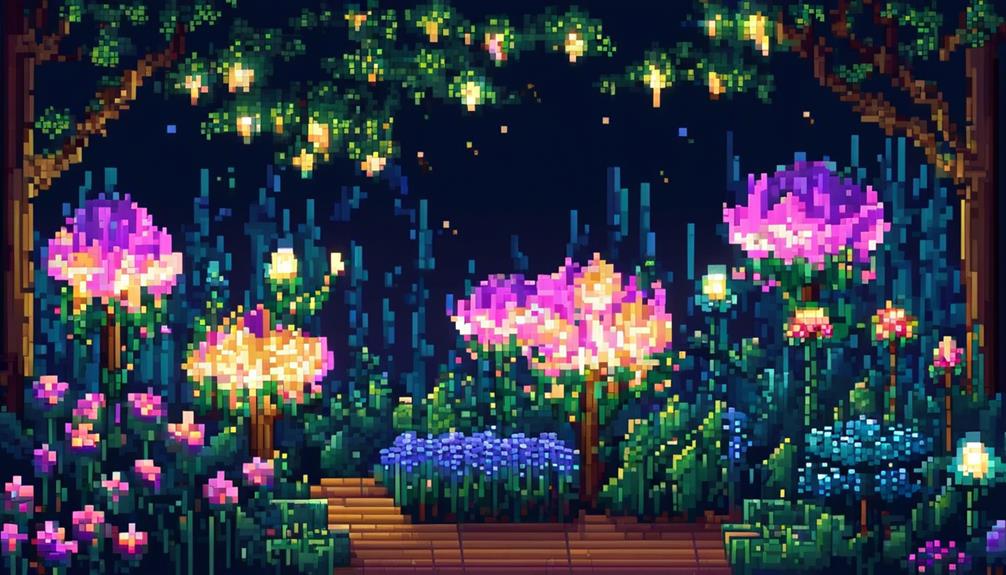
Outdoor lighting can be enhanced and transformed with the use of durable and weather-proof fiber optics, creating versatile lighting effects in garden and outdoor spaces. Here are three key ways in which fiber optic technology can be utilized for outdoor lighting:
- End Emitting Fibers: These fibers are excellent for creating individual points of light that are far from a single source. They are commonly used to achieve a light-painting effect, where the fibers are arranged to create intricate patterns or designs. End emitting fibers can add a touch of creativity and uniqueness to any outdoor lighting project.
- Side Emitting Fibers: Unlike end emitting fibers, side emitting fibers gradually release light along their length. This creates a diffused glow that can be used for various lighting purposes. Side emitting fibers are often employed for creating defined lines of light or under-lit elements, such as pathways or water features. They offer a soft and elegant illumination that complements the natural surroundings.
- Fiber Optic Variants: There are several common variants of fiber optics that are suitable for outdoor lighting projects. These include multi-strand end glow cables, fiber optic ribbon cables, and fiber optic fabric. Each variant offers different features and benefits, allowing DIY enthusiasts to choose the most appropriate option for their specific needs. For example, the flexibility of fiber optic fabric makes it ideal for creating dynamic and flexible lighting effects.
When working with fiber optic outdoor lighting, it is important to consider the methods for attaching lights to the fibers. Superglue or epoxy can be used for end glow fibers, while heat shrink tubes and fiber manipulation techniques can be employed for various lighting effects. By exploring the possibilities of fiber optic technology, DIY enthusiasts can create stunning and innovative lighting solutions for their gardens and outdoor spaces.
Fiber Optic Christmas Decorations
Fiber optic Christmas decorations offer a festive and captivating way to illuminate your home during the holiday season. These decorations utilize fiber optic technology to create sparkling lights that add a magical ambiance to any space.
From fiber optic Christmas trees to lighted ornaments, these energy-efficient and long-lasting decorations are a cost-effective and customizable lighting solution for the holidays.
Festive Fiber Optics
Festive Fiber Optics, also known as Fiber Optic Christmas Decorations, offer a captivating and customizable lighting solution for enhancing the ambiance of holiday decorations. With their ability to create stunning and mesmerizing lighting effects, they are perfect for adding a touch of magic to any festive setting.
Whether used to create a starry night ceiling or to illuminate an outdoor garden, fiber optics provide a unique and eye-catching glow. DIY fiber optic lighting projects are not only cost-effective but also energy-efficient, making them an ideal choice for festive decor.
With materials such as fiber optic cables, light sources, connectors, and cutting tools, anyone can create their own festive fiber optic display. The long lifespan of fiber optics ensures that these decorations will continue to delight for many holiday seasons to come.
Sparkling Holiday Lights
Sparkling Holiday Lights add a dazzling and enchanting touch to Christmas decorations, using the versatile and durable technology of fiber optics. By incorporating addressable LEDs and fiber optic cables, a wide range of lighting effects can be achieved, creating a magical atmosphere during the holiday season.
For instance, the Rubiks Cube 2x2x2 by AndreaFaveroin is a popular DIY project that utilizes fiber optics to create a mesmerizing light show. Another option is the Optic Fairy, a small device that connects to fiber optic cables and produces beautiful twinkling lights.
Whether it's using end emitting fibers to create tiny stars or side emitting fibers for diffused ambient lighting, fiber optics offer flexibility in design and application, making them ideal for creating sparkling holiday lights.
Fiber Optic Jewelry and Accessories
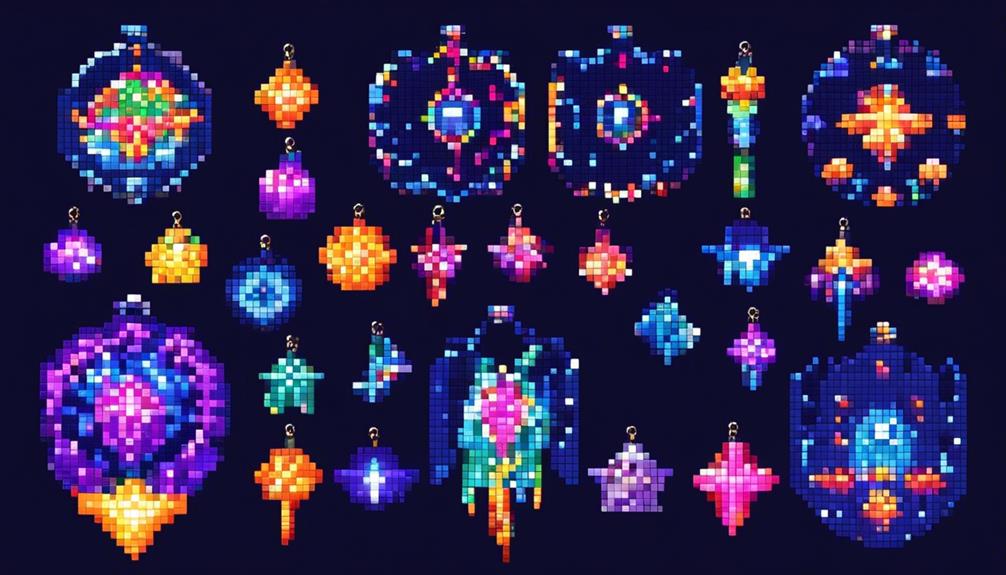
The use of fiber optic technology in jewelry and accessories offers a durable and versatile way to incorporate unique lighting effects. Fiber optics can be used to add a touch of elegance and innovation to various wearables and accessories.
Here are three ways fiber optic technology is used in fiber optic jewelry and accessories:
- End emitting fibers: These fibers create bright points of light at the ends and can be used to make light-painting effects or create tiny stars in jewelry pieces. By attaching end emitting fibers to pendants, earrings, or bracelets, designers can create stunning visual effects that captivate the wearer and onlookers alike.
- Side emitting fibers: Unlike end emitting fibers, side emitting fibers gradually let light escape along the length, creating a diffused glow and defined lines of light. This feature makes them ideal for creating unique lighting effects in accessories such as handbags, belts, or clothing. The diffused glow adds an ethereal touch to these pieces, making them stand out in any setting.
- Common fiber optic variants: There are various types of fiber optic cables and fabrics that can be used in fiber optic jewelry and accessories. Multi-strand end glow cable allows for creating intricate designs with multiple points of light, while fiber optic ribbon cables provide a wider band of light. Additionally, fiber optic fabric can be integrated into clothing or accessories, offering flexibility and versatility in lighting effects.
These fiber optic jewelry and accessories can be created as part of DIY fiber optic projects, allowing individuals to unleash their creativity and design unique pieces tailored to their personal style. The applications of fiber optic technology in jewelry and accessories are endless, offering an exciting fusion of fashion and technology.
Fiber Optic Sensor Applications
With its wide range of applications, fiber optic technology extends beyond the realm of jewelry and accessories and finds significant use in various industries through fiber optic sensor applications. These sensors are highly versatile and can be utilized for a variety of purposes due to their unique properties.
One of the key advantages of fiber optic sensors is their ability to cover long distances while maintaining accuracy and reliability. This makes them ideal for applications where traditional sensors would be impractical or ineffective. For example, in structural health monitoring, fiber optic sensors can be used to detect strain, deformation, and potential failure in buildings, bridges, and pipelines. Their immunity to electromagnetic interference also makes them well-suited for temperature monitoring in harsh environments.
In the medical field, fiber optic sensors play a crucial role in minimally invasive surgeries, patient monitoring, and biomedical research. Their small size and flexibility allow for precise measurements and real-time monitoring of various physiological parameters. Additionally, fiber optic sensors are utilized in industrial applications to detect pressure, vibration, and acoustic emissions, ensuring equipment safety and performance.
Environmental monitoring is another area where fiber optic sensors excel. They can be used to measure pollutants, detect leaks in pipelines, and monitor natural disasters such as earthquakes and landslides. Their ability to withstand extreme conditions and cover large areas makes them invaluable in these critical situations.
Fiber Optic Communication Systems
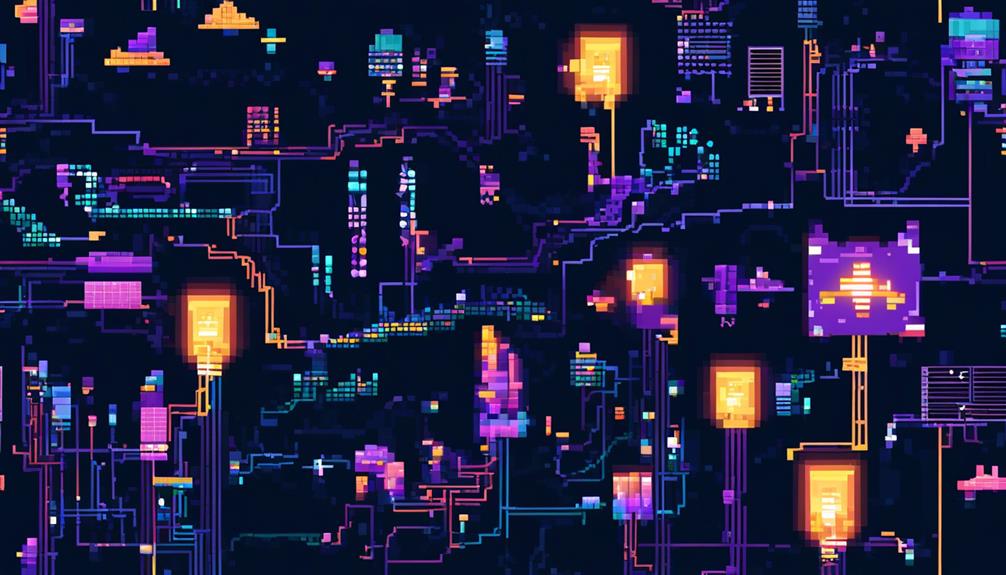
Fiber optic communication systems revolutionize data transmission by utilizing the principles of total internal reflection to transmit high-speed data as pulses of light through optical fibers. These systems have become the backbone of modern communication networks, enabling the transmission of vast amounts of information quickly and efficiently.
Here are three key aspects of fiber optic communication systems:
- Speed and Efficiency: The speed of light in fiber optics allows for fast and efficient communication over long distances. Data can be transmitted at incredible speeds, reaching up to several terabits per second. This high bandwidth capacity makes fiber optic communication systems ideal for applications that require the rapid transfer of large amounts of data, such as video streaming, cloud computing, and telecommunication networks.
- Different Types of Fiber Optic Cables: Fiber optic communication systems utilize different types of fiber optic cables to transmit light. End emitting fibers, also known as step-index fibers, are commonly used for point-to-point communication. They have a high refractive index core surrounded by a lower refractive index cladding, which helps keep the light confined to the core. Side emitting fibers, on the other hand, emit light along the length of the fiber, making them suitable for applications like decorative lighting and signage.
- Benefits of Fiber Optic Communication: Fiber optic communication systems offer numerous advantages over traditional copper-based systems. They are more durable and less susceptible to electromagnetic interference, ensuring reliable data transmission. Furthermore, fiber optics are energy-efficient, requiring less power to transmit signals compared to copper wires. These benefits make fiber optic communication systems highly desirable for a wide range of applications, including DIY fiber optic projects and various commercial and industrial applications.
Fiber Optic Audio and Music Projects
Fiber optic audio and music projects involve the integration of optical fibers and lighting effects to enhance the visual and auditory experience of music performances and installations. These projects utilize various types of fiber optic cables to create unique lighting effects that synchronize with the music. End emitting fibers are commonly used to create bright points of light at the ends, allowing for light-painting effects and starry effects. On the other hand, side emitting fibers emit light gradually along the length, making them ideal for under-lit elements and defined lines of light.
To achieve these lighting effects, different types of fiber optic cables can be used. Multi-strand end glow cables, fiber optic ribbon cables, and fiber optic fabric are some of the common variants that are employed. Each variant offers different lighting effects and can be used creatively to enhance the ambiance of the music performance or installation.
Attaching lights to the fibers is an essential step in these projects. Superglue, heat shrink tubes, and fiber manipulation techniques can be used to connect LEDs to the fibers securely. This ensures that the lights are properly aligned with the fibers to achieve the desired lighting effects.
Understanding the properties of optical fibers is crucial in fiber optic audio and music projects. These fibers are composed of a core and cladding and rely on the principle of total internal reflection to transmit light. They have low loss and high bandwidth, making them suitable for transmitting audio signals.
Fiber Optic Science Experiments and Education
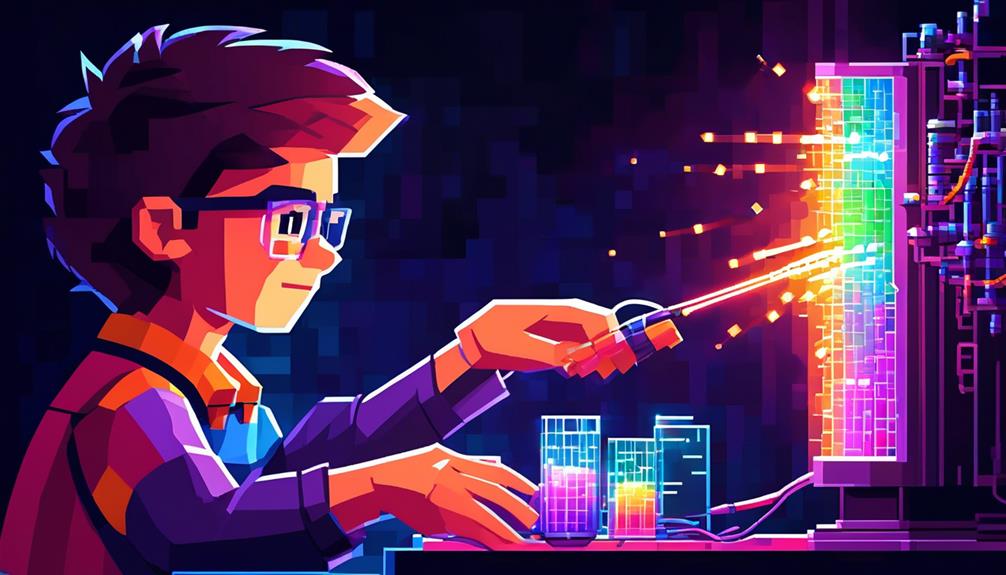
In the realm of fiber optic applications, an exploration of fiber optic science experiments and education unveils a world of innovative possibilities for learning and discovery. Fiber optic projects offer a unique way to engage students in hands-on experiments that promote scientific understanding and creativity.
Here are three exciting examples of fiber optic science experiments and educational projects:
- Light Painting: Fiber optics can be used to create mesmerizing light painting effects. By attaching a light source to one end of an end emitting fiber, students can experiment with different shapes and patterns, capturing stunning images with long exposure photography. This project not only teaches the properties of light and the principles of optics but also encourages artistic expression and experimentation.
- Fiber Optic Sensing: Fiber optic cables can be used as sensors to measure various physical quantities such as temperature, pressure, and strain. Students can learn about the principles of optical sensing and perform experiments to observe how different factors affect the behavior of light in the fiber. This project promotes critical thinking and problem-solving skills while introducing students to real-world applications of fiber optics in industries such as aerospace, civil engineering, and medicine.
- Fiber Optic Communication: Fiber optic communication is the backbone of modern telecommunications systems. Students can build simple fiber optic communication systems using LEDs and optical fibers to transmit signals over short distances. Through this project, students gain an understanding of the fundamentals of data transmission, including concepts such as modulation, encoding, and decoding. They also learn about the advantages of fiber optics over traditional copper-based communication systems, such as higher bandwidth and immunity to electromagnetic interference.
Frequently Asked Questions
What Are 5 Applications of Fiber Optics?
Fiber optics have numerous applications across various industries. They offer advantages in telecommunications, such as high-speed data transmission, low signal loss, and increased bandwidth.
Fiber optic sensors are used for environmental monitoring, providing accurate and reliable data on temperature, pressure, and chemical composition.
In interior design, fiber optic lighting is popular for its versatility and ability to create unique lighting effects.
These applications demonstrate the technical precision and informative capabilities of fiber optics in different fields.
What Can You Make With Fiber Optic Cable?
Fiber optic cables have a wide range of applications. These include the creation of fiber optic jewelry, fiber optic Christmas decorations, and fiber optic sensory toys. These projects utilize the unique properties of fiber optic cables. For example, they can emit light over long distances and create visually pleasing effects. By incorporating fiber optics into these projects, designers can achieve stunning lighting effects. Additionally, they can minimize power consumption and maximize the flexibility and versatility of the final product.
How Do You Use Fiber Optic Strands for Crafts?
Fiber optic strands offer endless possibilities for crafting. Their versatility allows for the creation of stunning fiber optic jewelry, adding a touch of elegance to any outfit.
When it comes to holiday decorations, fiber optic strands can be used to bring a magical glow to Christmas ornaments and light up the festive season.
Additionally, these strands can be incorporated into sensory toys, providing a captivating visual experience for children.
With their precision and durability, fiber optic strands are a valuable asset in the world of crafting.
Can You Run Your Own Fiber Optic Cable?
Running your own fiber optic cable requires technical knowledge and specialized equipment. Fiber optic installation involves carefully planning the route, preparing the cable, and terminating the ends correctly.
It is crucial to ensure proper fiber optic network design, including considerations like signal loss, bend radius, and splicing techniques. Additionally, certification and testing of the installed cable are necessary to guarantee optimal performance.
Due to the complexity involved, it is recommended to hire professionals for fiber optic installation to ensure a reliable and efficient network.
